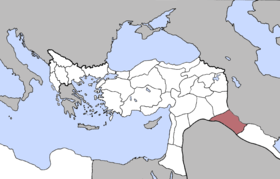Vilayet of Baghdad
|
ولايت بغداد Vilâyet-i Bagdad, |
|||||
| Vilayet of the Ottoman Empire | |||||
|
|||||
| Baghdad Vilayet in 1900 | |||||
| Capital | Baghdad | ||||
| History | |||||
| • | Established | 1869 | |||
| • | Armistice of Mudros | 1918 | |||
| Area | |||||
| • | 1885 | 141,160 km2(54,502 sq mi) | |||
| Population | |||||
| • | 1885 | 850,000 | |||
| Density | 6 /km2 (15.6 /sq mi) | ||||
| Today part of |
|
||||
The Vilayet of Baghdad (Ottoman language: ولايت بغداد, Vilâyet-i Bagdad, Modern Turkish: Bağdat Vilâyeti, Arabic:ولاية بغداد) was a first-level administrative division (vilayet) of the Ottoman Empire in modern-day central Iraq. The capital was Baghdad.
At the beginning of the 20th century it reportedly had an area of 54,503 square miles (141,160 km2), while the preliminary results of the first Ottoman census of 1885 (published in 1908) gave the population as 850,000. The accuracy of the population figures ranges from "approximate" to "merely conjectural" depending on the region from which they were gathered.
In 1869 Midhat Pasha was inaugurated as governor of Baghdad. He extended Ottoman jurisdiction as far as the town of al-Bida, after he had established his authority in Nejd. In January 1872, Qatar was designated as a kaza under the Sanjak of Nejd. However, relations with the Ottoman authorities became hostile in both al-Bida and Nejd, which eventually led to the Battle of Al Wajbah, where the Ottomans were defeated.
Sanjaks of the vilayet:
Notable governors of the Vilayet:
...
Wikipedia

